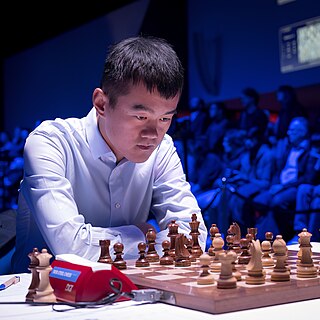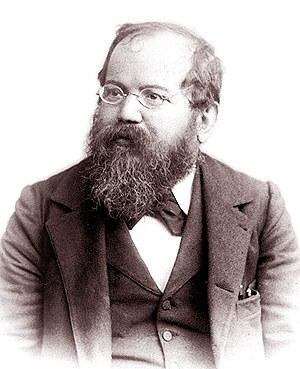
The World Chess Championship is played to determine the world champion in chess. The current world champion is Ding Liren, who defeated his opponent Ian Nepomniachtchi in the 2023 World Chess Championship. Magnus Carlsen, the previous world champion, had declined to defend his title.

William Steinitz was a Bohemian-Austrian and, later, American chess player. From 1886 to 1894, he was the first World Chess Champion. He was also a highly influential writer and chess theoretician.

Karl Ernst Adolf Anderssen was a German chess master. He won the great international tournaments of 1851 and 1862, but lost matches to Paul Morphy in 1858, and to Wilhelm Steinitz in 1866. Accordingly, he is generally regarded as having been the world's leading chess player from 1851 to 1858, and leading active player from 1862 to 1866, although the title of World Chess Champion did not yet exist.

Johannes Hermann Zukertort was a Polish-born British-German chess master. He was one of the leading world players for most of the 1870s and 1880s, but lost to Wilhelm Steinitz in the World Chess Championship 1886, which is generally regarded as the first World Chess Championship match. He was also defeated by Steinitz in 1872 in an unofficial championship.

Joseph Henry Blackburne was a British chess player. Nicknamed "The Black Death", he dominated the British scene during the latter part of the 19th century. Blackburne learned the game at the relatively late age of 17 or 18, but he quickly became a strong player and went on to develop a professional chess career that spanned over 50 years. At one point he was one of the world's leading players, with a string of tournament victories behind him, and popularised chess by giving simultaneous and blindfold displays around the country. Blackburne also published a collection of his own games.

Romantic chess is a style of chess popular in the 18th century until its decline in the 1880s. This style of chess emphasizes quick, tactical maneuvers rather than long-term strategic planning. Romantic players consider winning to be secondary to winning with style. The Romantic era of play was followed by the Scientific, Hypermodern, and New Dynamism eras. Games during this era generally consisted of 1.e4 openings such as the King's Gambit and Giuoco Piano. Queen-side pawn openings were not popular and seldom played. The Romantic era is generally considered to have ended with the 1873 Vienna tournament where Wilhelm Steinitz popularized positional play and the closed game. This domination ushered in a new age of chess known as the "Modern", or Classical school, which would last until the 1930s when hypermodernism began to become popular.
Miksa (Max) Weisz was an Austrian chess player born in the Kingdom of Hungary.
The Oxford University Chess Club (OUCC) was founded at the University of Oxford in 1869. It is the oldest university chess club in the United Kingdom. The Club meets each Wednesday evening during University term time. They field two teams in the Oxfordshire Chess League.

Baron Ignatz von Kolisch, also Baron Ignaz von Kolisch (German) or báró Kolisch Ignác (Hungarian), was a merchant, journalist and chess master with Jewish roots.

Samuel Rosenthal was a Polish-born French chess player. Chess historian Edward Winter wrote, "He dedicated his life to chess-playing, touring, writing, teaching and analysing. Despite only occasional participation in first-class events, he scored victories over all the leading masters of the time. He also acquired world renown as an unassuming showman who gave large simultaneous displays and blindfold séances, invariably producing a cluster of glittering moves."

London 1851 was the first international chess tournament. The tournament was conceived and organised by English player Howard Staunton, and marked the first time that the best chess players in Europe would meet in a single event. Adolf Anderssen of Germany won the sixteen-player tournament, earning him the status of the best player in the world.
Miksa (Max) Fleissig was a Hungarian-born Austrian chess master.
Bernhard (Bernát) Fleissig was an Austrian chess master.
Philipp Meitner was an Austrian lawyer and chess master. His most famous game was the "Immortal Draw". He won at Vienna 1875, and won a match against Adolf Schwarz (6½–3½) at Vienna 1878.
Carl Hamppe was a senior government official in Vienna as well as a Swiss-Austrian chess master and theoretician.

The tournament celebrated the fiftieth anniversary of Emperor Franz Joseph I of Austria's accession to the throne of Austria-Hungary. Main organiser was Baron Albert Freiherr von Rothschild who also financed the Vienna tournaments of 1873, 1882, 1903, and 1908. The players visited his Heugasse palace on 31 May 1898. Rounds were played in the clubhouse of the Wiener Schachklub at Schottengasse 7. Hugo Fahndrich was the tournament director at Kaiser Jubiläumsturnier 1898. The time limit was thirty moves in two hours, and fifteen moves per hour after this. Twenty great masters played double rounds from 1 June to 25 July.
Hugo Fähndrich was an Austrian–Hungarian chess master.

The second international Vienna 1882 chess tournament was one of the longest and strongest chess tournaments ever played. According to the unofficial Chessmetrics ratings, the tournament was the strongest tournament in history, on the basis that nine of the ten top players in the world participated, including all of the top eight.
World exhibitions became a new phenomenon in the West in the nineteenth century. Scientific and technical progress were shown. About a dozen World Fairs were organised during the second half of the nineteenth century. Seven times an international invitation chess tournament was part of the event. The third tournament took place in the Grand Cercle, 10 boulevard Montmartre, Paris, from 4 June to 11 July. Thirteen participants played in a double round-robin tournament. Draws counted as zero. The time control was ten moves an hour.
 Joseph Henry Blackburne (United Kingdom)
Joseph Henry Blackburne (United Kingdom) Wilhelm Steinitz (Bohemia)
Wilhelm Steinitz (Bohemia) Adolf Anderssen (German Empire)
Adolf Anderssen (German Empire) Samuel Rosenthal (France)
Samuel Rosenthal (France) Louis Paulsen (German Empire)
Louis Paulsen (German Empire) Henry Edward Bird (United Kingdom)
Henry Edward Bird (United Kingdom) Josef Heral (Austria)
Josef Heral (Austria) Max Fleissig (Hungary)
Max Fleissig (Hungary) Philipp Meitner (Austria)
Philipp Meitner (Austria) Adolf Schwarz (Hungary)
Adolf Schwarz (Hungary) Oscar Gelbfuhs (Austria)
Oscar Gelbfuhs (Austria) Karl Pitschel (Austria)
Karl Pitschel (Austria)








